Viewing the Fall foliage on Jay Peak Resort’s tram. Courtesy photo
by Timothy McQuiston, Vermont Business Magazine
Travel and tourism have been a cornerstone of Vermont’s economy for over a century. However, recent years have brought significant disruptions, most notably the COVID-19 pandemic. Travel restrictions and lockdowns forced hospitality venues to close, impacting everything from cozy B&Bs to sprawling ski resorts.
As the pandemic restrictions eased, Vermont experienced a surge in tourism, leading to an economic boom. However, this influx of visitors also triggered a housing crisis, characterized by a decline in available housing and a rise in housing costs. This phenomenon involved the conversion of second homes into permanent residences and the transformation of permanent homes into short-term rentals.
While the ski industry was still recovering from the lingering effects of COVID, the hospitality sector was rebounding. However, two devastating events further disrupted travel and tourism: the floods of July 2023 and July 2024. Businesses in central Vermont, ranging from restaurants to recreational facilities, bore the brunt of these disasters, experiencing significant disruptions and setbacks.
One of the most obvious attractions affected was the Lamoille Valley Rail Trail, completed just before the 2023 flooding. The grand opening, featuring Gov. Scott and others biking its entire length from St. Albans to St. Johnsbury, was poised to attract numerous visitors and locals. However, the relentless flooding washed out sections of the trail, postponing the celebration and disrupting several hospitality businesses along the route.
The state, aided by federal funding, successfully restored the entire trail and planned another grand opening in 2024. However, the July floods once again caused significant damage, including washing out sections that had been repaired the previous year. As of today, the Lamoille Valley Rail Trail remains partially closed.
The Industry
Generating close to $3 billion in travel and tourism spending in 2023 and nearly $400 million in retail sales in 2022, tourism and recreation in Vermont supports over 30,000 jobs — more than 10% of Vermont’s workforce.
Vermont’s diverse outdoor recreation sector has significantly boosted local economies throughout the state. Contributing 4.6% to the state’s GDP last year, it ranked as the second-highest contributor nationally.
This thriving sector also saw a substantial 12.4% increase in its workforce, reaching 15,000 workers in 2022, marking the highest percentage growth in the nation.
Overall, travel and tourism have consistently played a crucial role in Vermont’s economy, serving as a resilient source of tax revenue. The rooms and meals tax, closely tied to tourism, has demonstrated strength even during challenging periods like the Great Recession, Tropical Storm Irene and the COVID-19 pandemic.
In fiscal year 2024, ending June 30, rooms and meals tax receipts exceeded those of the previous year, surpassing state economists’ expectations. The fiscal 2024 room and meals tax revenue reached $231.38 million, with two-thirds allocated to the general fund and one-third to the education fund, reflecting a 2.82% increase from the prior year.
The total rooms and meals tax revenue of $231.38 million is nearly equivalent to the corporate tax revenue and ranks as the third-highest source of general fund revenue, behind the personal income tax, which is nearly four times larger than both corporate and rooms and meals taxes.
There is not much data yet to gauge how the July 2024 flooding has affected businesses, though rooms and meals taxes, which tend to lag in reporting, were slightly off as of the July report, the most recent available.
Ski resorts have been grappling with weather disruptions in the past couple of years, separate from summer rain. Winter has seen an increase in rain events, impacting early season conditions.
While the season typically starts with cold weather, temperatures tend to rise around the holidays and into February, posing challenges for the industry. Fortunately, late-season skiing conditions have been favorable, extending the season into April and providing some relief.
“Every ski area I’ve talked to is excited about the coming ski season, and with early-season ticket sales and prebookings on par with previous years, it looks like visitors are too,“ said Bryan Rivard, communications director at Ski Vermont. “Even with some of the weather challenges we’ve seen recently, last season’s visitation numbers (2023-2024) were down only half a percentage point from the year before (putting Vermont at 4.1 million). In the context of the whole Northeast region, which reported a decline of 6.2%, Vermont fared well.
“I think that’s a reflection of the commitment ski areas have to the guest experience,“ Rivard added. “A large part of that is the snowmaking teams and investments ski areas continued to make in efficiency projects and snowmaking technology. They’re making snow more efficiently and nimbly than ever before, and skiers have taken notice, particularly in challenging weather. Many areas are also expanding programming of off-slope activities and options for nonskiers, so there’s something for everyone. I think that makes the decision to book earlier a lot easier.“
Tourism officials report that bookings for the waning foliage season and the upcoming ski season appear strong, suggesting a positive outlook for both. Historically, booking trends have been a reliable predictor of seasonal performance in the tourism industry.
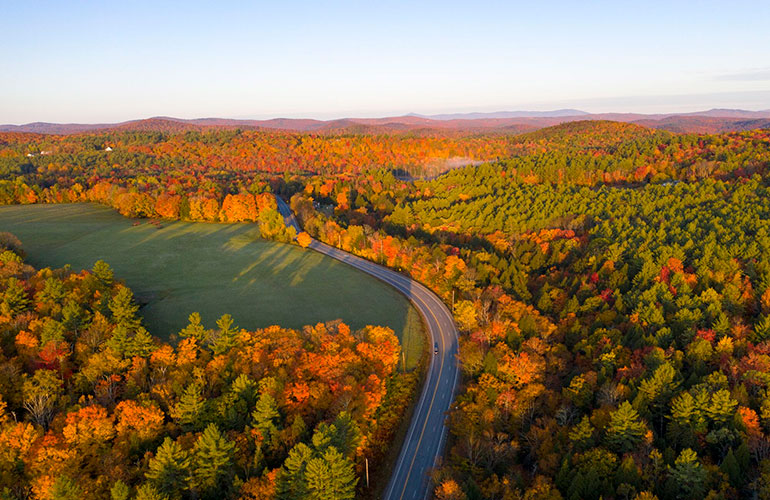
Photo: Aerial view of Vermont’s beautiful Fall foliage. VTFM photo
The Women’s World Cup ski race at Killington has been confirmed and is highly anticipated, particularly with Michaela Shiffrin’s expected return to defend her slalom championship. Despite the relatively early date in the season — the weekend after Thanksgiving — the Killington Cup has a history of excellent conditions.
Another factor to keep an eye on for general Vermont tourism is international travel. There is some evidence that people are traveling overseas more, in part because of the strong dollar, and not traveling domestically. This is not isolated to Vermont but is seen across the nation.
The vital outdoor recreation sector, meanwhile, received more good news with the opening of the first fully adaptable mountain biking trails in Bolton. These trails are made to accommodate the wider bikes used by adaptive athletes, as well as accommodating bikers and hikers of all levels.
Tourism Officials and Promoters
Heather Pelham, commissioner of the Vermont Department of Tourism and Marketing, said that in terms of this summer, 2024 was on track to be a bit stronger than 2023, but they were not seeing the year-over-year growth they did coming out of the pandemic when there was a lot of pent-up demand for travel.

Heather Pelham, VDTM’s commissioner of tourism. Courtesy photo
She noted that:
-
Vermont is experiencing the same trend seen nationally, with fewer U.S. residents traveling domestically year-over-year.
-
While the drop is not significant, inflationary pressures persist this year, and the U.S. dollar is stronger, leading some individuals to opt for overseas travel, especially if those trips were postponed during the pandemic.
-
Which adds up to say that with all of the disruptions we have seen over the last few years, it is hard to pinpoint what the “new normal“ is. One lasting trend we are seeing is shorter booking windows as people wait until closer to the date of their trip to make final bookings.
-
Anecdotal reports from around the state are that this summer has been “a bit soft“ and that some areas like the Northeast Kingdom did see drops in revenue following the severe weather in July.
-
Statewide, visitor spending is holding steady and traffic counts to the visitor centers are up 13% YTD, portending a strong fall season. Pacing data for accommodations for the fall is also showing bookings up about 10% from this same time last year.
“From our perspective,“ Pelham said, “the ski season ended a lot stronger than some folks expected, thanks to some late-season natural snowfall in March and the very impressive snowmaking abilities of our resorts.“
She added that travel data from the eclipse is still in process. The department is hoping to finish its report on the economic impact in the next few weeks.
The Department of Tourism and Marketing reported October 25 the results of two studies examining the economic impact of the total solar eclipse on April 8, 2024. Researchers found the eclipse generated $34.8 million in visitor spending, a welcome boost during the slowest month for tourism, but less than 10% of visitor spending during Vermont’s fall foliage season.
Tourism Economics estimates the eclipse brought an additional 175,000 visitors to Vermont who spent $34.8M during their stay, contributing $2.6M in sales and meals and rooms taxes to state and local coffers. The estimated total economic impact is $54M. Meanwhile, fall foliage visitors come to enjoy Vermont, so they stay longer and spend more overall. Vermont estimates 2.5 million visitors spend approximately $500 million annually during the entire fall foliage season.
Prior to the April 8 eclipse, State Treasurer Mike Pieciak released a report estimating its potential economic impact between $12.9 million and $51.8 million, contingent on weather conditions. Fortunately, the weather cooperated with sunny skies and unusually warm temperatures.
The report projected visitor numbers ranging from 52,000 to 208,000, based on analyses of the 2017 eclipse in Wyoming, Nebraska and South Carolina. Shortly after the event, Transportation Secretary Joe Flynn, utilizing University of Vermont analysis, estimated 160,000 visitors arrived by car alone, inferred from an additional 60,000 vehicles (averaging 2.8 people per vehicle) during the preceding days.
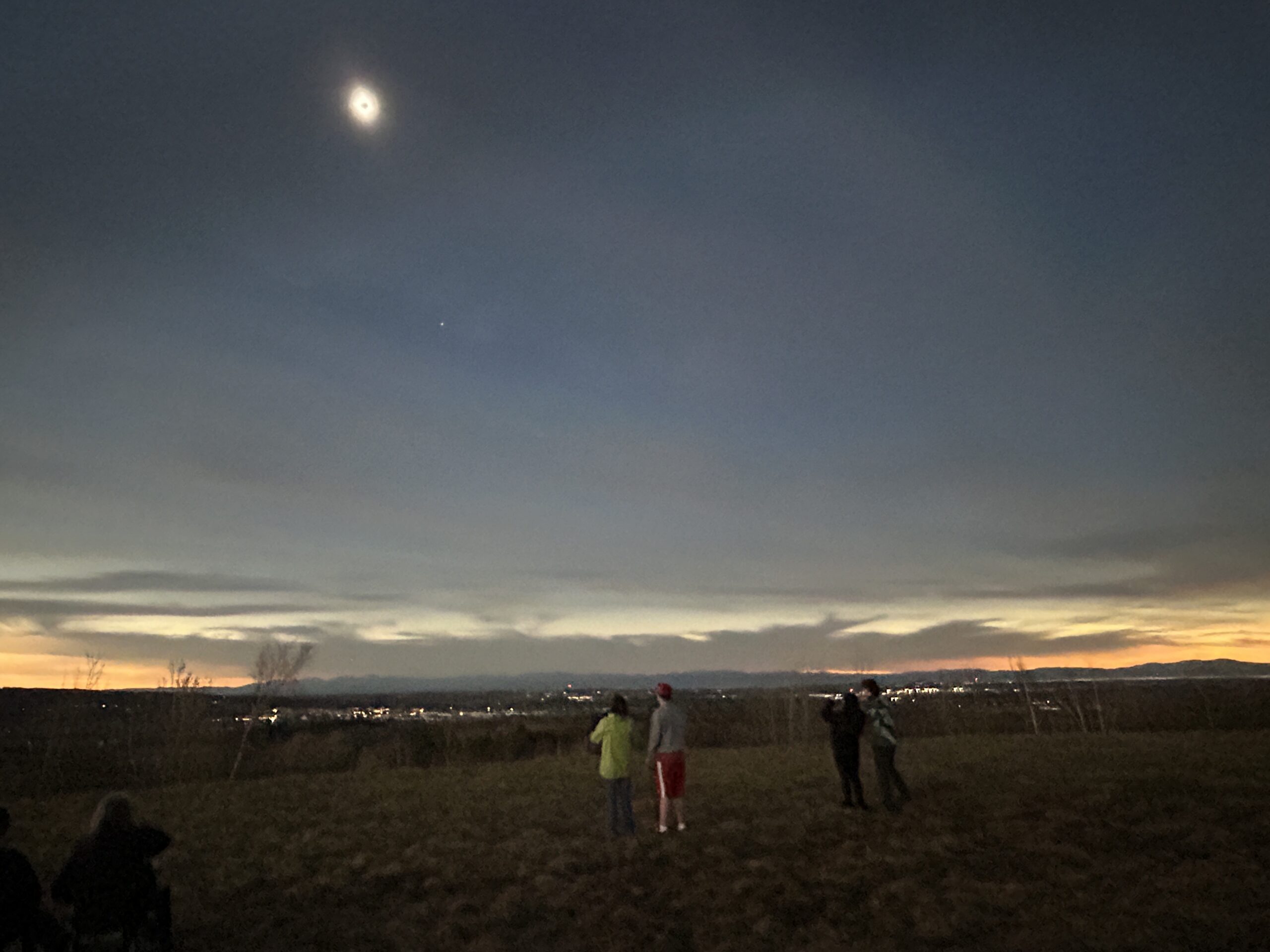
Eclipse watchers in Williston, overlooking Burlington, Lake Champlain and the Adirondacks. VermontBiz photo.
“Vermont’s tourism and hospitality industry has certainly been tested over the last few years,“ said Amy Spear, president of the Vermont Chamber of Commerce, “particularly with the flooding events that impacted many of our communities and businesses as they were working to regain footing post-pandemic. Despite these challenges, the sector has shown remarkable resilience.
“Vermont’s natural beauty and outdoor recreation opportunities,” she added, “are central to our state’s identity and economy, drawing millions of visitors each year. However, the growing impacts of climate change pose significant challenges to our tourism industry, from unpredictable weather patterns to shifts in the landscape that impact the experiences our visitors seek.“
While some destinations experienced a soft summer, the summer season broadly speaking had strong occupancy rates,“ Spear said.
“As we look ahead to the foliage season, early indicators suggest that Vermont will once again be a top destination,“ she noted. “Our partners within the industry are reporting solid bookings, and we expect the season to continue drawing visitors eager to experience Vermont’s iconic landscape.“
According to the September tax revenue report, the Meals & Rooms tax was again off, as it was in July and August. The M&R is one indicator of tourism activity.
According to Interim Administration Secretary Sarah Clark: “Solid receipts in personal and corporate income taxes have bolstered the first quarter of the State’s 2025 fiscal year, although we are beginning to see some weakness in consumption taxes, which accounts for the small underperformance of the Education Fund relative to the consensus forecast. More will be known next month when consumption tax receipts will more accurately reflect the cumulative results of the summer tourism season.”
In terms of winter, while weather patterns can present challenges, Vermont’s ski industry remains strong, Spear added.
Ski Vermont reported that the state’s alpine ski areas welcomed 4.1 million skier visits for the 2023-24 season. Visitation was 4% above Vermont’s 10-year average and outpaced a 6.2% decrease in Northeast region visits (12.4 million) and a 6.6% drop in national visits (60.4 million), according to data from the National Ski Areas Association.
Spear also noted that:
-
While the rooms and meals tax does lag as an indicator, the strength seen so far reflects the industry’s ongoing recovery and strong consumer interest in travel to Vermont.
-
However, tax revenues only show one portion of the operational landscape for businesses. While tax revenues are increasing, operational pressures have also increased.
-
Businesses across Vermont are facing the cumulative impact of numerous financial challenges, such as supply- chain disruptions, labor shortages, inflation, rising property taxes and a new payroll tax.
-
The eclipse was a boon to Vermont’s economy. It had the same economic impact as Indigenous Peoples’ Day weekend (formerly known as Columbus Day) and the peak weekend for fall foliage.
Kim Hewitt, director of marketing and resort sales at Jay Peak Resort, reported that, like many in the hospitality industry, the resort experienced a surge in bookings for 2022-23 as guests from both the U.S. and Canada were finally able to travel freely again.
“We went into last winter with a good reservations pace, but also cautiously, knowing that the post-COVID season would be difficult to replicate,“ Hewitt said. “Weather conditions were tough last season, especially across the Christmas holidays. It’s difficult to recover from the loss of any holiday period, so when the stretch of mediocre weather continued into February there was some hand-wringing around here, for sure.“
Hewitt said Jay Peak’s lodging revenue remained steady due to several factors: its reputation for abundant snowfall (crucial during a low-snow year); the appeal of its indoor waterpark as a weatherproof attraction; diverse offerings including hockey, which isn’t weather-dependent; and a unique sequence of four consecutive holiday weeks (Presidents Week, Vermont break week and Ontario break week) that most other resorts don’t benefit from.
Revenue related to days markets and guests — notably lift tickets and related per caps — were down significantly, she added, “until we got lucky with some well-timed, late-season storms hitting right around the winter break weeks and more again in April which, paired with the windfall that was the eclipse, pushed us to a very strong finish.
“Many other mountains had, unfortunately, been forced to close early because of the lack of snow, which likely pushed more skiers and riders our way, especially in late March and April. The return season of ’22-’23 set a high bar, which we beat in ’23-’24.
Hewitt reported that this positive trend has persisted throughout the summer, with Jay Peak on track for its most successful golf season yet, boasting a nearly 25% increase in rounds played compared to the same period last year.
“We’ve had to pull back on promotions because tee times through the rest of the season are limited, due to strong lodging bookings and advance rounds sold,“ Hewitt explained.
Lodging revenue is currently 20% ahead of last year’s figures, and October, historically the resort’s strongest off-season month, is also showing positive trends, Hewitt said.
She added that the resort was seeing positive signs for a strong winter 2024-25 season, with season pass sales currently pacing 15% ahead of last year, and lodging bookings, even without the eclipse surge, remaining comparable to last year, which would be significantly ahead of any other non-eclipse season.
“Despite these encouraging numbers, we’re heading into winter ’24-’25 very aware of the shift in economic factors that are affecting all our guests,“ Hewitt said. “We’re all feeling the pinch as it continues to cost more and more to cover the basics like rent, food and gas, leaving less and less for adventures like ski and waterpark vacations.“
To ease the financial impact on customers, Hewitt said the resort has identified areas where it can freeze or reduce rates. For example, winter lift ticket rates, rental rates and waterpark tickets will remain unchanged from last year.
“We’ve been releasing a series of winter lodging deals across various time periods and properties to offer all our guests access to the best rates possible,“ Hewitt said. “Our next deal will focus on deeply discounted packages for the Vermont and Quebec winter break weeks. We’ll continue to look for ways to put out products, packages and discounts that will make skiing, riding and waterparking feasible, especially for families.“
Aside from freezing and reducing rates, the resort is scheduling events that will offer added value to its guests, Hewitt said. For the second year, they’ll kick off winter with WinterShine, a celebration of the start of the season, holiday lights and community. The event includes a weekly lighting ceremony, fireworks and family activities.
The resort is also introducing a new month-long celebration of all things maple in April. This event will span three consecutive weekends and feature activities such as sugar on snow, a “cabane à sucre“-inspired brunch, hayrides and live music.
More details on both the WinterShine and mapling events will be available soon on the Jay Peak website..
Jackie Dagger, program manager at the Vermont Outdoor Recreation Economic Collaborative within the Agency of Commerce, reported that Vermont state park usage has increased and that outdoor recreation has remained strong, even during the pandemic. However, she acknowledged that the negative weather events of the past few years have impacted the industry and the perception of Vermont as a destination, highlighting the importance of climate resilience as a state objective.
Dagger mentioned that the best source for tracking trends in Vermont’s outdoor recreation economy is the annual data from the Bureau of Economic Analysis. This data, she said, shows that the sector remained resilient throughout the pandemic, rebounding quickly in 2021 after a significant drop in 2020 and growing substantially in 2022. As a result, the contribution of outdoor recreation to Vermont’s GDP reached 4.6%, the second-highest in the nation.
“We know that increased rain and warmer winters are having an impact on outdoor recreation in Vermont,“ Dagger said. “That is why we proposed in Move Forward Together Vermont’s Draft Vision and Priority Actions that climate resilience be one of the common objectives we focus on over the next five years. For the past two summers, we’ve heard stories about severe flooding and rain causing lengthy trail, park and business closures in the parts of the state hit the hardest.
“We’ve also heard about the economic impacts on businesses that rely on popular outdoor recreation destinations such as Vermont state parks and trail network. The data to tell us the extent of the impact on Vermont’s outdoor recreation economy hasn’t quite caught up to us yet.“
Dagger noted that between 2022 and 2023, there was a slight decrease in visitation to Vermont state parks, but skier visits saw a significant increase, almost reaching pre-pandemic levels.
Preliminary visitation data for state parks for 2024 show an overall increase of 13.56% from 2023, including a day-use increase of 22.8% and an increase in camping by 5%. These numbers reflect visitation in Vermont state parks prior to Labor Day and will be updated once all the parks have closed for the season.
According to marketing specialist Pam Knights of Pam Knights Communications, visitors consider four key factors when planning a trip: travel, lodging, dining and recreational activities. Unfortunately, many of Vermont’s restaurants have been forced to shutter their doors, due either to inflation, the summer flooding of the past two summers or the lingering financial effects of the coronavirus pandemic.
“Fortunately,“ she said, “new ones pop up, many not knowing the rigors of the hospitality industry and what it will take to be successful.“
Though some tried-and-true restaurants are faring well, many others are still dealing with rising food prices, interruptions from road construction and finding adequate help, Knights noted.
“Without good restaurants, Vermont’s tourism industry would be adversely affected,“ she said. “Restaurants are also major supporters of Vermont’s farm economy and help to keep the working landscape viable.“
Chris Moore, managing partner of the 106-year-old Wayside Restaurant in Montpelier, said that after resuming full operations post-COVID in spring 2022, business quickly returned to normal.
“The flooding over the past two years that closed Montpelier and Barre’s downtown businesses led to an increase in the Wayside’s traffic, as we were one of the only restaurants open in the area,“ he said. “After a busy foliage season last year, we’re gearing up for another busy one this fall.
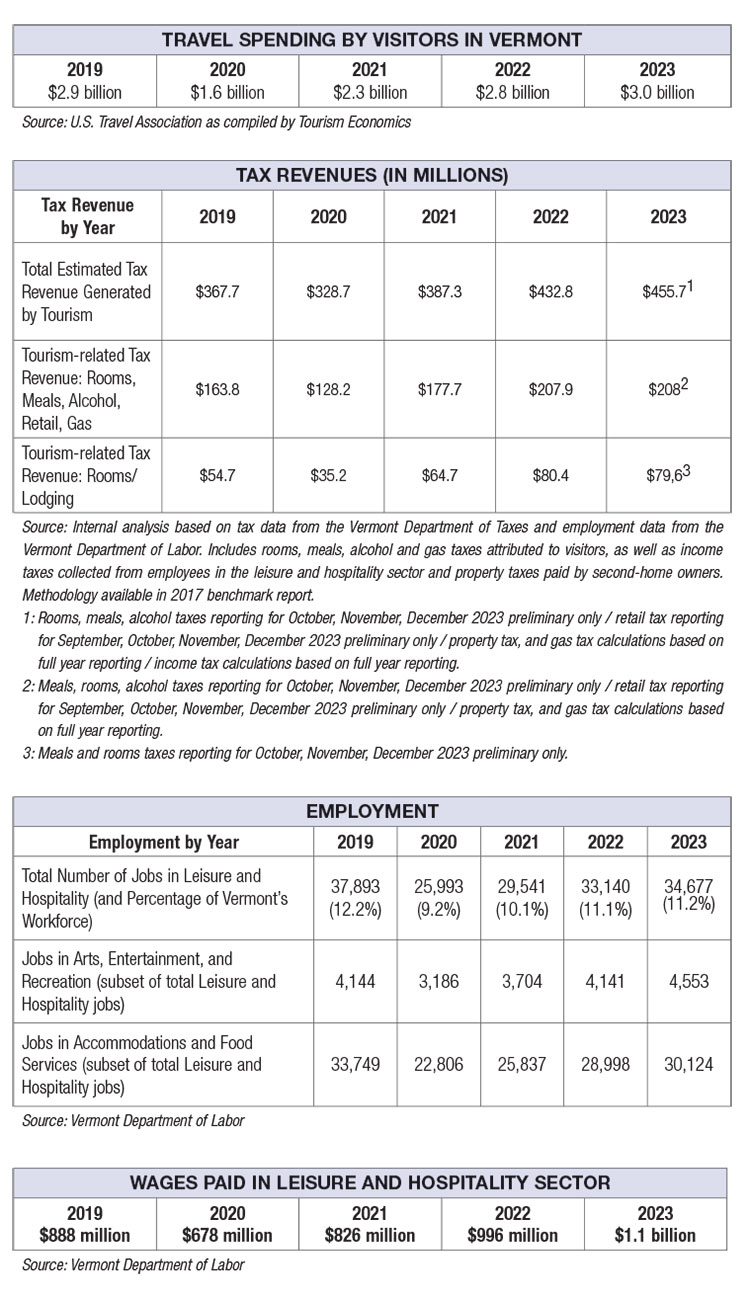
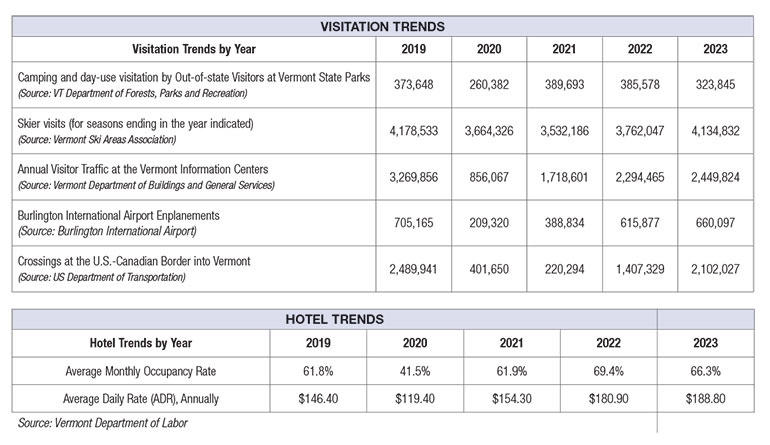
The Driving Range for Adaptive Mountain Biking
Hosted by the Richmond Mountain Trails, a celebration of the Driving Range in Bolton, the state’s first fully accessible trail network, was held in September. The event included a hike around RMT’s new adaptive-ready trail system and a discussion with Vermont tourism officials, the Vermont Chamber of Commerce and state, local and industry leaders on tourism and outdoor recreation in Vermont.
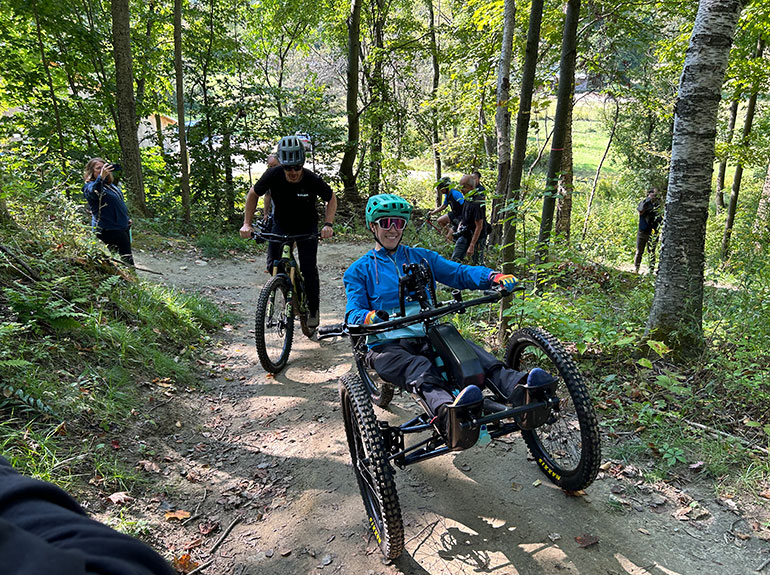
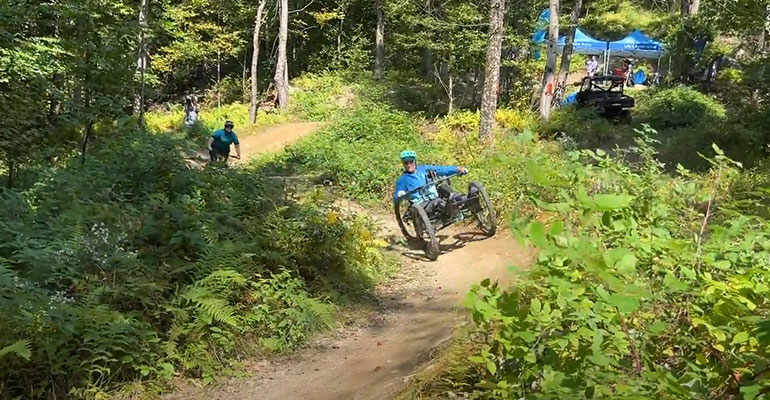
Kelly Brush ride her hand-pedal, electric-assist bikes at the Driving Range mountain bike trail in Bolton. VermontBiz photos.
Participants, led by U.S. Sen. Peter Welch (D-Vermont), met high up on the trail on a glorious September afternoon. The panel, which included Lindsey DesLauriers, president and CEO of Bolton Valley Resort; Kelly Brush, founder of the Kelly Brush Foundation; Kim Jackson, director of communications at Vermont Adaptive; and Kelly Ault, executive director of the Vermont Outdoor Business Alliance, discussed the challenges and issues facing the travel and outdoor recreation industry.
Those issues, the panelists agreed, include accessibility, cross-border travel and business, infrastructure repairs, immigration policy reforms, rural development, and the need for outdoor recreation marketing and development funding.
“Vermont’s travel and outdoor recreation industry is an economic driver in our state, drawing folks from across the country and around the world to enjoy nature and community at its best,“ Welch said. “We’ve seen how back-to-back floods have impacted so much of our state, including this crucial sector, but it is clear today Vermont is open and ready for the fall tourism season.“
The Driving Range trail is so-called because the parking area for the trail head is at the former home of a golf driving range just off U.S. Route 2.
The recreation area itself includes two trails. One is a two-way trail for all levels of hiking and biking. The other is a downward trail for biking only; it features challenging jumps for thrill-seekers, but also bypasses for adaptive athletes using wider bikes, such as those sported by Brush.
It’s not just a metaphor that on a mountain bike trail, the bridges have to be wide enough.
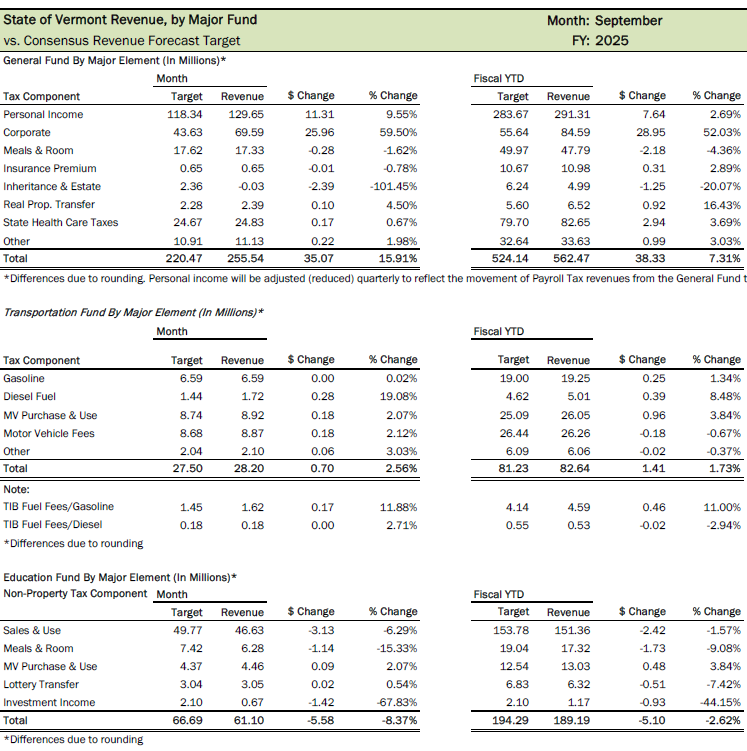
To support vital journalism, access our archives and get unique features like our award-winning profiles, Book of Lists & Business-to-Business Directory, subscribe HERE!
This post was originally published on here








